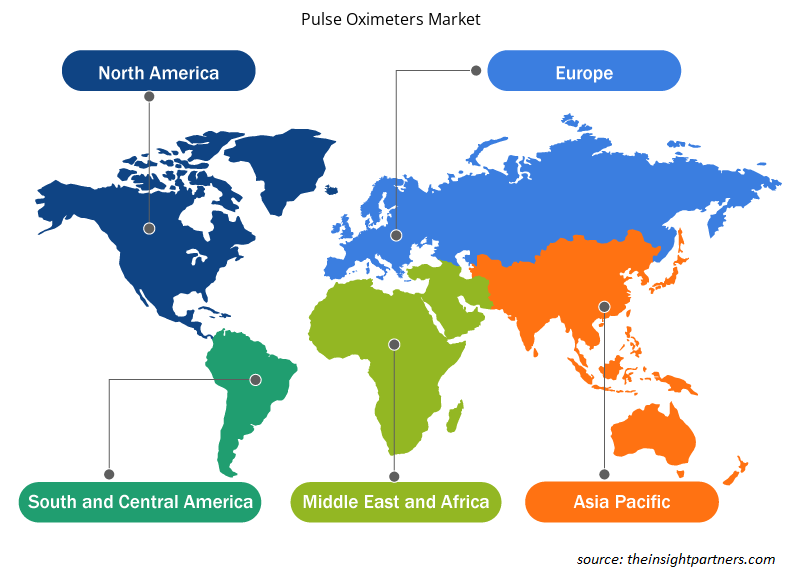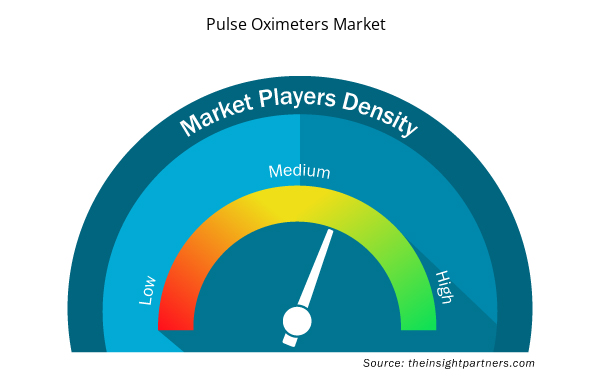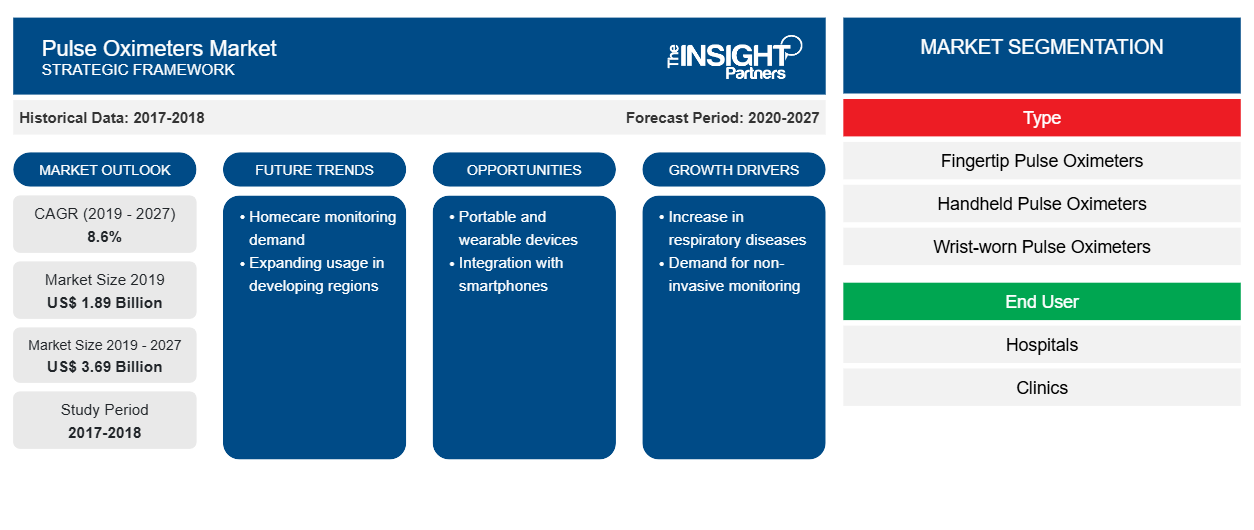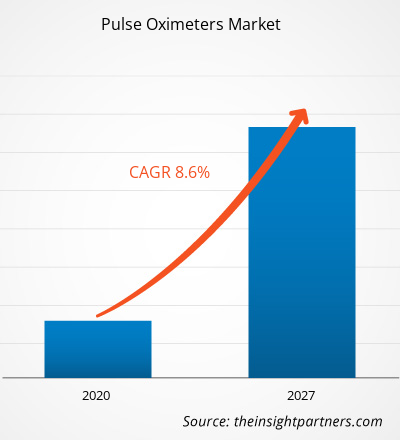2019 年脉搏血氧仪市场价值为 18.92 亿美元,预计到 2027 年将达到 36.9392 亿美元;预计 2020-2027 年期间的复合年增长率为 8.6%。
脉搏血氧仪是一种非侵入式设备,用于监测血液中的氧饱和度。它是一种小型夹子状设备,可固定在手指或耳垂上。它主要用于重症监护、手术、急救和高海拔患者,用于评估患者的氧合情况,以确定是否需要补充氧气。此外,脉搏血氧仪市场对患有心脏病、呼吸系统疾病和慢性阻塞性肺病的患者也很有用。
市场洞察
呼吸系统疾病患病率上升推动市场增长
呼吸系统疾病的患病率不断上升,这与随着年龄增长,上呼吸道管腔尺寸减小有关。全球很大一部分人口患有各种类型的呼吸系统疾病。吸烟、遗传因素和感染是导致呼吸系统疾病的常见因素。慢性阻塞性肺病 (COPD)、睡眠呼吸暂停、心律失常、缺血性疾病、糖尿病、高血压和哮喘是给各国公共医疗系统带来沉重负担的疾病。根据美国肺脏协会的数据,COPD 是美国第三大死亡原因,其中超过 1640 万人被诊断出患有该病。此外,根据美国卫生与公众服务部的数据,2019 年美国约有 2500 万人患有哮喘,这是世界上最常见的呼吸系统疾病之一。患有这些呼吸系统疾病的患者通常会呼吸困难和缺氧。脉搏血氧仪是一种非侵入性且安全的血氧饱和度测量方法。
全球范围内 COVID-19 病例数量的不断增加也推动了对脉搏血氧仪的需求。持续监测呼吸参数是 COVID-19 患者治疗的主要阶段之一。因此,为了准确管理和治疗 COVID-19 病例,医护人员依赖脉搏血氧仪和其他多参数监测仪。此外,不同类型的脉搏血氧仪设备被广泛用于家庭常规监测。
定制此报告以满足您的需求
您可以免费定制任何报告,包括本报告的部分内容、国家级分析、Excel 数据包,以及为初创企业和大学提供优惠和折扣
- 获取此报告的关键市场趋势。这个免费样品将包括数据分析,从市场趋势到估计和预测。
产品洞察
就类型而言,指尖脉搏血氧仪占据了 2019 年脉搏血氧仪市场的最大份额,预计在预测期内将继续保持主导地位并在市场上实现更高的复合年增长率。
传感器类型洞察
根据传感器类型,全球脉搏血氧仪市场分为可重复使用和一次性。可重复使用部分在 2019 年占据了最大的市场份额,预计在预测期内将实现最高的复合年增长率。增长可归因于全球 COVID-19 患者的增加。
最终用户洞察
根据最终用户,全球脉搏血氧仪市场分为医院、诊所和其他。诊所部分在 2019 年占据了最大的市场份额,预计其他部分在预测期内的复合年增长率最高。
脉搏血氧仪是一种小型、轻便的设备,用于监测体内携带的氧气量。指尖脉搏血氧仪是非侵入式的、易于使用且体积小巧,这使其成为婴儿和新生儿的首选。它附着在指尖,并发送两种波长的光来测量脉搏率和氧气水平。评估完成后,屏幕显示氧气百分比和当前脉搏率。患有心脏或呼吸问题的人依靠指尖脉搏血氧仪来帮助他们管理这些病症。例如,哮喘患者可以使用血氧仪来评估发作的严重程度。根据 CDC 的数据,在美国,约有 1920 万成年人患有哮喘。准确的脉搏率和 SpO2 读数对于氧气水平频繁下降的患者尤为重要。
脉搏血氧仪市场的参与者采用合作和合作伙伴策略,通过推出先进的技术产品来满足最终用户的需求,这些策略极大地支持了市场的增长。
脉搏血氧仪市场区域洞察
Insight Partners 的分析师已详尽解释了预测期内影响脉搏血氧仪市场的区域趋势和因素。本节还讨论了北美、欧洲、亚太地区、中东和非洲以及南美和中美洲的脉搏血氧仪市场细分和地理位置。

- 获取脉搏血氧仪市场的区域特定数据
脉搏血氧仪市场报告范围
| 报告属性 | 细节 |
|---|---|
| 2019 年市场规模 | 18.9亿美元 |
| 2027 年市场规模 | 36.9亿美元 |
| 全球复合年增长率(2019 - 2027) | 8.6% |
| 史料 | 2017-2018 |
| 预测期 | 2020-2027 |
| 涵盖的领域 | 按类型
|
| 覆盖地区和国家 | 北美
|
| 市场领导者和主要公司简介 |
|
脉搏血氧仪市场参与者密度:了解其对业务动态的影响
脉搏血氧仪市场正在快速增长,这得益于终端用户需求的不断增长,这些需求源于消费者偏好的不断变化、技术进步以及对产品优势的认识不断提高等因素。随着需求的增加,企业正在扩大其产品范围,进行创新以满足消费者的需求,并利用新兴趋势,从而进一步推动市场增长。
市场参与者密度是指在特定市场或行业内运营的企业或公司的分布情况。它表明在给定市场空间中,相对于其规模或总市场价值,有多少竞争对手(市场参与者)存在。
脉搏血氧仪市场的主要运营公司有:
- 诺宁
- 荷兰皇家飞利浦公司
- Vyaire Medical 有限公司
- 史密斯医疗
- Hill Rom 控股公司
免责声明:上面列出的公司没有按照任何特定顺序排列。

- 获取脉搏血氧仪市场顶级关键参与者概述
按类型
- 指尖脉搏血氧仪
- 手持式脉搏血氧仪
- 腕戴式脉搏血氧仪
- 儿科脉搏血氧仪
按传感器类型
- 可重复使用的
- 一次性的
按最终用户
- 医院
- 诊所
- 其他的
按地理位置
北美
- 我们
- 加拿大
- 墨西哥
欧洲
- 法国
- 德国
- 意大利
- 英国
- 俄罗斯
亚太地区
- 中国
- 印度
- 韩国
- 日本
- 澳大利亚
中东和非洲
- 南非
- 沙特阿拉伯
- 阿联酋
南美洲和中美洲
- 巴西
- 阿根廷
公司简介
- 诺宁
- 荷兰皇家飞利浦公司
- VYAIRE 医疗公司
- 史密斯医疗
- Hill Rom 控股公司
- 爱德华生命科学公司
- 美敦力
- 马西莫
- 博雅有限公司
- 马克斯泰克
- 历史分析(2 年)、基准年、预测(7 年)及复合年增长率
- PEST 和 SWOT 分析
- 市场规模价值/数量 - 全球、区域、国家
- 行业和竞争格局
- Excel 数据集


- Skin Tightening Market
- Single-Use Negative Pressure Wound Therapy Devices Market
- Collagen Peptides Market
- Non-Emergency Medical Transportation Market
- Bioremediation Technology and Services Market
- Adaptive Traffic Control System Market
- Sodium Bicarbonate Market
- Medical and Research Grade Collagen Market
- Artificial Intelligence in Healthcare Diagnosis Market
- Bio-Based Ethylene Market

Report Coverage
Revenue forecast, Company Analysis, Industry landscape, Growth factors, and Trends

Segment Covered
This text is related
to segments covered.

Regional Scope
North America, Europe, Asia Pacific, Middle East & Africa, South & Central America

Country Scope
This text is related
to country scope.
常见问题
The inaccuracies in pulse oximeter readings due to several factors is the significant factor that will hinder the pulse oximeters market growth.
The global neuromodulation market is being driven by factors such increasing prevalence of respiratory diseases, growing preference for remote patient monitoring. Furthermore, strategic developments by manufacturers is likely to offer significant opportunities for the growth of the global pulse oximeters market.
Pulse oximeter is a non-invasive device used for monitoring oxygen saturation level in blood. It is a small, clip-like device that is attached to a body like finger or earlobe. It is mostly used in intensive care, operating, emergency care, and patient at high altitude for assessment of patient’s oxygenation to determine if there is need for supplemental oxygen. Furthermore, pulse oximeters are useful for patients with cardiac problem, respiratory problems, and chronic obstructive pulmonary diseases.
Trends and growth analysis reports related to Life Sciences : READ MORE..
The List of Companies - Pulse Oximeters Market
- Nonin
- Koninklijke Philips N.V.
- Vyaire Medical, Inc.
- Smiths Medical
- Hill Rom Holding Inc.
- Edwards Lifesciences Corporation
- Medtronic
- Masimo
- Beurer GmbH
- Maxtec
The Insight Partners performs research in 4 major stages: Data Collection & Secondary Research, Primary Research, Data Analysis and Data Triangulation & Final Review.
- Data Collection and Secondary Research:
As a market research and consulting firm operating from a decade, we have published and advised several client across the globe. First step for any study will start with an assessment of currently available data and insights from existing reports. Further, historical and current market information is collected from Investor Presentations, Annual Reports, SEC Filings, etc., and other information related to company’s performance and market positioning are gathered from Paid Databases (Factiva, Hoovers, and Reuters) and various other publications available in public domain.
Several associations trade associates, technical forums, institutes, societies and organization are accessed to gain technical as well as market related insights through their publications such as research papers, blogs and press releases related to the studies are referred to get cues about the market. Further, white papers, journals, magazines, and other news articles published in last 3 years are scrutinized and analyzed to understand the current market trends.
- Primary Research:
The primarily interview analysis comprise of data obtained from industry participants interview and answers to survey questions gathered by in-house primary team.
For primary research, interviews are conducted with industry experts/CEOs/Marketing Managers/VPs/Subject Matter Experts from both demand and supply side to get a 360-degree view of the market. The primary team conducts several interviews based on the complexity of the markets to understand the various market trends and dynamics which makes research more credible and precise.
A typical research interview fulfils the following functions:
- Provides first-hand information on the market size, market trends, growth trends, competitive landscape, and outlook
- Validates and strengthens in-house secondary research findings
- Develops the analysis team’s expertise and market understanding
Primary research involves email interactions and telephone interviews for each market, category, segment, and sub-segment across geographies. The participants who typically take part in such a process include, but are not limited to:
- Industry participants: VPs, business development managers, market intelligence managers and national sales managers
- Outside experts: Valuation experts, research analysts and key opinion leaders specializing in the electronics and semiconductor industry.
Below is the breakup of our primary respondents by company, designation, and region:

Once we receive the confirmation from primary research sources or primary respondents, we finalize the base year market estimation and forecast the data as per the macroeconomic and microeconomic factors assessed during data collection.
- Data Analysis:
Once data is validated through both secondary as well as primary respondents, we finalize the market estimations by hypothesis formulation and factor analysis at regional and country level.
- Macro-Economic Factor Analysis:
We analyse macroeconomic indicators such the gross domestic product (GDP), increase in the demand for goods and services across industries, technological advancement, regional economic growth, governmental policies, the influence of COVID-19, PEST analysis, and other aspects. This analysis aids in setting benchmarks for various nations/regions and approximating market splits. Additionally, the general trend of the aforementioned components aid in determining the market's development possibilities.
- Country Level Data:
Various factors that are especially aligned to the country are taken into account to determine the market size for a certain area and country, including the presence of vendors, such as headquarters and offices, the country's GDP, demand patterns, and industry growth. To comprehend the market dynamics for the nation, a number of growth variables, inhibitors, application areas, and current market trends are researched. The aforementioned elements aid in determining the country's overall market's growth potential.
- Company Profile:
The “Table of Contents” is formulated by listing and analyzing more than 25 - 30 companies operating in the market ecosystem across geographies. However, we profile only 10 companies as a standard practice in our syndicate reports. These 10 companies comprise leading, emerging, and regional players. Nonetheless, our analysis is not restricted to the 10 listed companies, we also analyze other companies present in the market to develop a holistic view and understand the prevailing trends. The “Company Profiles” section in the report covers key facts, business description, products & services, financial information, SWOT analysis, and key developments. The financial information presented is extracted from the annual reports and official documents of the publicly listed companies. Upon collecting the information for the sections of respective companies, we verify them via various primary sources and then compile the data in respective company profiles. The company level information helps us in deriving the base number as well as in forecasting the market size.
- Developing Base Number:
Aggregation of sales statistics (2020-2022) and macro-economic factor, and other secondary and primary research insights are utilized to arrive at base number and related market shares for 2022. The data gaps are identified in this step and relevant market data is analyzed, collected from paid primary interviews or databases. On finalizing the base year market size, forecasts are developed on the basis of macro-economic, industry and market growth factors and company level analysis.
- Data Triangulation and Final Review:
The market findings and base year market size calculations are validated from supply as well as demand side. Demand side validations are based on macro-economic factor analysis and benchmarks for respective regions and countries. In case of supply side validations, revenues of major companies are estimated (in case not available) based on industry benchmark, approximate number of employees, product portfolio, and primary interviews revenues are gathered. Further revenue from target product/service segment is assessed to avoid overshooting of market statistics. In case of heavy deviations between supply and demand side values, all thes steps are repeated to achieve synchronization.
We follow an iterative model, wherein we share our research findings with Subject Matter Experts (SME’s) and Key Opinion Leaders (KOLs) until consensus view of the market is not formulated – this model negates any drastic deviation in the opinions of experts. Only validated and universally acceptable research findings are quoted in our reports.
We have important check points that we use to validate our research findings – which we call – data triangulation, where we validate the information, we generate from secondary sources with primary interviews and then we re-validate with our internal data bases and Subject matter experts. This comprehensive model enables us to deliver high quality, reliable data in shortest possible time.


 获取此报告的免费样本
获取此报告的免费样本